The Dolomites
Winter 2023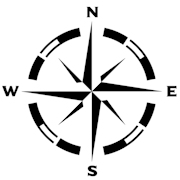
Wintertime In The Dolomites
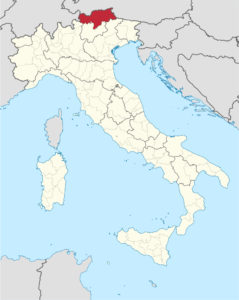 In February of 2023 Cindy and I returned to the Dolomites (and the Italian province of Südtirol) for the third time in three years. All told we’ve now spent about ten weeks in the area and are really starting to learn our way around! We first visited this mountainous, outdoor-oriented wonderland in January of 2020, only a few short weeks before COVID turned the world upside down. Little did we know that it would take us 2-1/2 years to make a much-warranted return trip to the area in September of 2022 – a five week ‘revenge travel’ adventure that you can read about via this link. That fall return trip just wasn’t enough for us, so we arranged this February 2023 trip just a few short months later to explore the area in the wintertime.
In February of 2023 Cindy and I returned to the Dolomites (and the Italian province of Südtirol) for the third time in three years. All told we’ve now spent about ten weeks in the area and are really starting to learn our way around! We first visited this mountainous, outdoor-oriented wonderland in January of 2020, only a few short weeks before COVID turned the world upside down. Little did we know that it would take us 2-1/2 years to make a much-warranted return trip to the area in September of 2022 – a five week ‘revenge travel’ adventure that you can read about via this link. That fall return trip just wasn’t enough for us, so we arranged this February 2023 trip just a few short months later to explore the area in the wintertime.
The Dolomites span seven northern Italian provinces with arguably the greatest concentration in Südtirol, where countless pinnacles, massifs, plateaus, cliffs, and valleys combine to create postcard views no matter which way you look. While technically part of the Alps, you’ll rarely if ever hear the locals (or the local tourism offices) refer to these mountains as anything other than the Dolomites. It’s a dramatic landscape filled with eighteen light gray limestone peaks topping out over 10,000 feet and countless others not far below that. There are also a number of alpine meadows that present a soft green contrast to the otherwise rocky and sometimes almost lunar landscape. Factor in the fall spectacle of thousands of larch trees turning brilliant gold and it’s no wonder that the mountains were named as a UNESCO World Heritage Site in 2009.
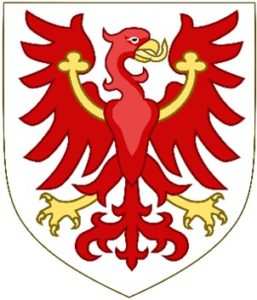 Südtirol (also known as South Tyrol in English and Alto Adige in Italian) is the northernmost province in Italy and shares roughly half of its border with Austria. In fact Südtirol was part of Austria until immediately after World War I when it was granted to Italy as part of Austria’s war reparations. It has been a full century since Südtirol’s annexation but the overall character of the people, language, architecture, and food are still quite Germanic (and proudly so). That’s not to say, however, that there isn’t a distinct Italian flair in the larger towns and cities like Bolzano and Merano. The total population of Südtirol is just over 500,000 people, about 60% of whom claim German as their primary language. This percentage gets notably higher as you move north and/or away from the larger cities and towns, so it’s sometimes hard to believe that you’re actually in Italy when you’re out enjoying the more remote areas of the province and hearing nothing but German or the regional Ladin.
Südtirol (also known as South Tyrol in English and Alto Adige in Italian) is the northernmost province in Italy and shares roughly half of its border with Austria. In fact Südtirol was part of Austria until immediately after World War I when it was granted to Italy as part of Austria’s war reparations. It has been a full century since Südtirol’s annexation but the overall character of the people, language, architecture, and food are still quite Germanic (and proudly so). That’s not to say, however, that there isn’t a distinct Italian flair in the larger towns and cities like Bolzano and Merano. The total population of Südtirol is just over 500,000 people, about 60% of whom claim German as their primary language. This percentage gets notably higher as you move north and/or away from the larger cities and towns, so it’s sometimes hard to believe that you’re actually in Italy when you’re out enjoying the more remote areas of the province and hearing nothing but German or the regional Ladin.
As a side note, Südtirol enjoys a special status as an autonomous province of Italy. This status, granted to five of the twenty Italian provinces, means that the provincial government has more freedom in terms of self-governance. These provinces also retain a much larger share of their tax revenues for local use vs. funding the national treasury. While this autonomy is intended to help preserve each region’s unique cultural fabric, the most visible result for travelers in Südtirol is the noteworthy investment in transit systems and tourism infrastructure. The trains and buses tend to be quite new, logically scheduled, and (without mentioning a certain name from Italy’s not-too-distant past) they certainly do run on time.
For this trip we flew Delta from Richmond to Atlanta where we connected to our flight to Munich. After clearing customs at Flughafen München we took the S-Bahn commuter railway to Munich’s Ostbahnhof where we boarded an ÖBB or Österreichische Bundesbahnen train for our transit south through Austria and the storied Brenner Pass. When we arrived at Fortezza, the first major stop in Italy, we switched to regional transportation for the train ride to Innichen. It was a long trip of around 28 hours and did include one unscheduled adventure during that final leg – but more about that later!
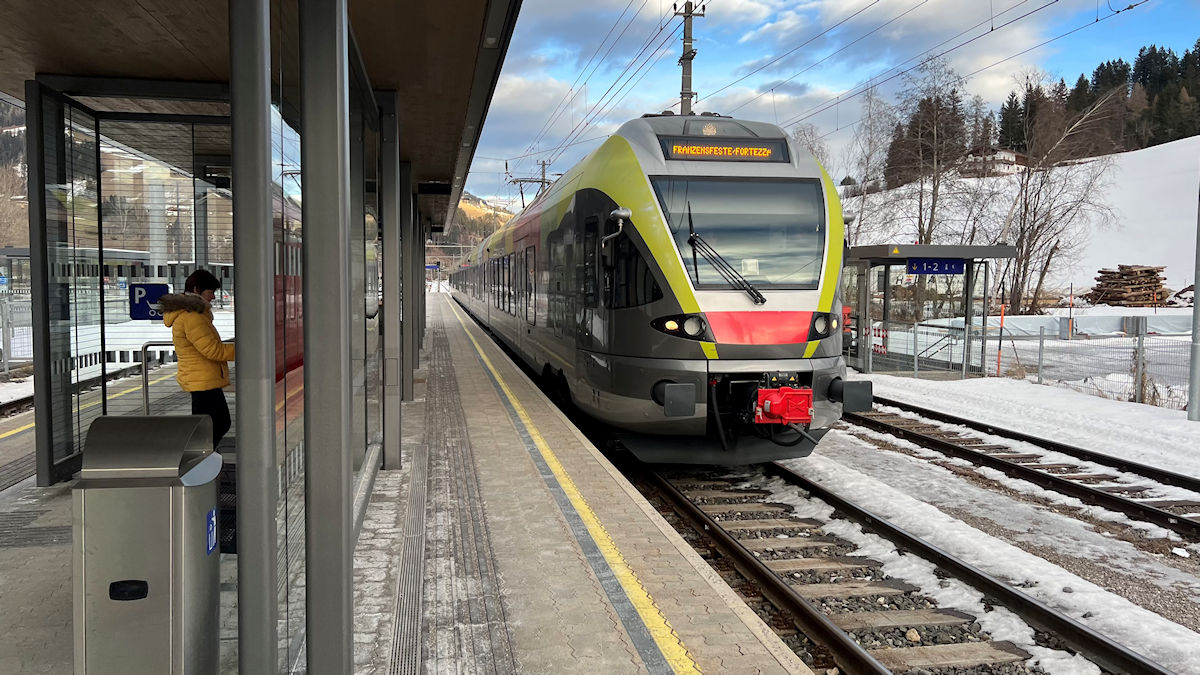 As with our past trips to Europe we did not rent a car because we much prefer going local and using only regional trains and buses. This saves us the expense of renting a car, the exorbitant cost of gas, questions about licensing and insurance, and the hassle of parking. It also eliminates the stress on both the driver and navigator caused by the narrow and winding mountain roads – taking the bus or train leaves both passengers free to enjoy the scenery.
As with our past trips to Europe we did not rent a car because we much prefer going local and using only regional trains and buses. This saves us the expense of renting a car, the exorbitant cost of gas, questions about licensing and insurance, and the hassle of parking. It also eliminates the stress on both the driver and navigator caused by the narrow and winding mountain roads – taking the bus or train leaves both passengers free to enjoy the scenery.
Not having a car meant that we needed to plan our days around the published schedules and routes for buses and trains. This was more than offset by gaining the option to take what we call ‘open jaw’ hikes where we were able to combine two or more hiking routes so long as the end points were each accessible by train or bus. For example we could start in one valley, traverse a mountain saddle, and descend into a different valley to some other trailhead. This tended to put us on trails with much lower foot traffic as none of the car-bound folks had this same flexibility.
Cindy and I stayed in two locations over the course of this three week adventure : Innichen from February 4 to February 17, and then Castelrotto from February 18 to February 25. We also spent a lovely night a very snowy Garmisch, Germany, on our way back to the Flughafen München. You can read more about each location and our adventures there by clicking on the links in this paragraph or at the bottom of the page.
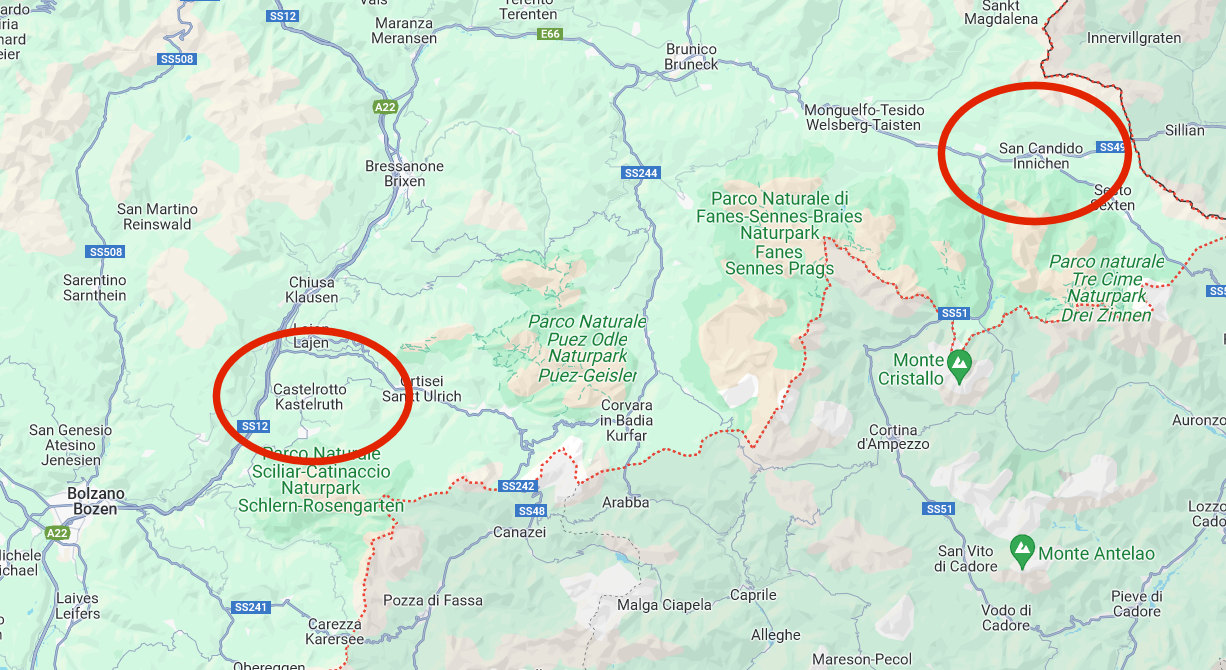
These two locations were carefully chosen for access to local adventures, great views of the Dolomites, and (needless to say) their charm. From a more practical perspective they both had easy access to the regional bus and train networks, a fair-sized grocery store, and appropriate lodging. The lodging requirement presented a bit of challenge. We prefer to stay in furnished holiday apartments (known as Ferienwohnungen in German) but this region tends to be more geared to hotel-style properties so finding true bedrooms and full kitchens wasn’t always easy!
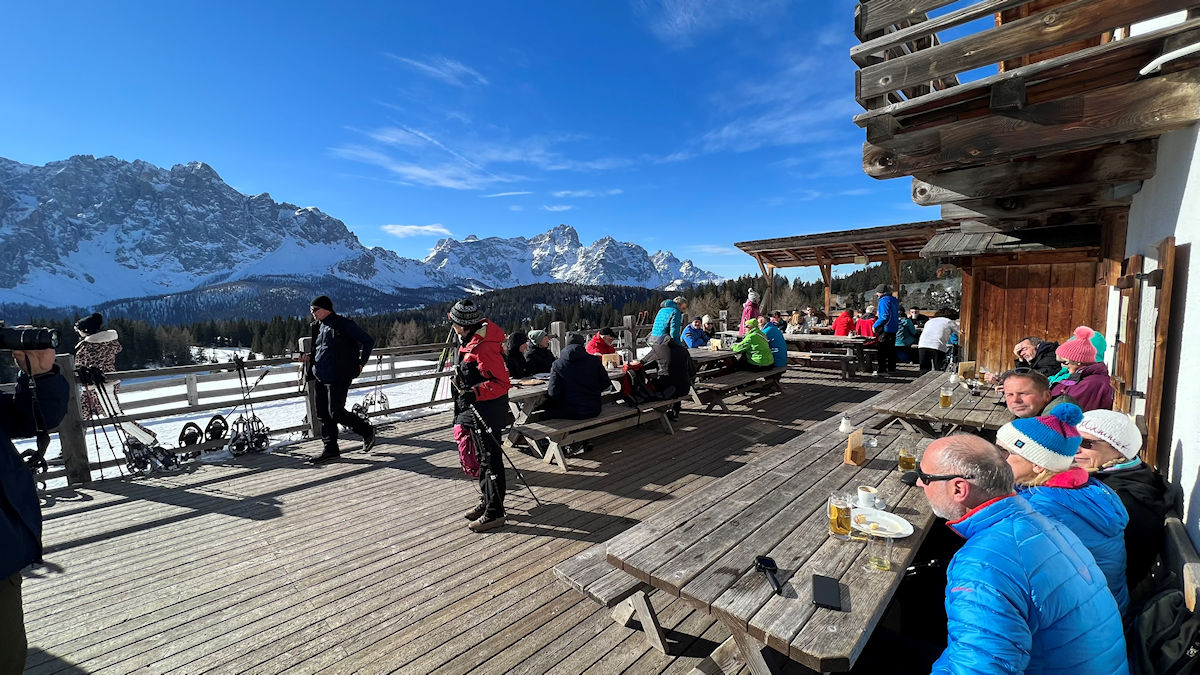 Cindy and I learned during our earlier visits to the Dolomites that Hütte Culture (not to be confused with haute couture!) is very much a part of your experience in this region. Whether you’re skiing in the winter or hiking in the summer the odds are that you will stumble across a rifugio (Italian) or hütte (German) nestled in a mountain pass or perched high on a rocky summit. In fact there are ninety (90) of these mountain huts in the Südtirol that provide basic overnight accommodation for through-hikers plus countless more that are pleasant day-hiker destinations for drinks, home-cooked food, and restrooms. You are guaranteed quaint architecture, excellent regional fare, and a unique atmosphere that is often just as memorable as the scenery along the way.
Cindy and I learned during our earlier visits to the Dolomites that Hütte Culture (not to be confused with haute couture!) is very much a part of your experience in this region. Whether you’re skiing in the winter or hiking in the summer the odds are that you will stumble across a rifugio (Italian) or hütte (German) nestled in a mountain pass or perched high on a rocky summit. In fact there are ninety (90) of these mountain huts in the Südtirol that provide basic overnight accommodation for through-hikers plus countless more that are pleasant day-hiker destinations for drinks, home-cooked food, and restrooms. You are guaranteed quaint architecture, excellent regional fare, and a unique atmosphere that is often just as memorable as the scenery along the way.
Speaking of lunches, the food in Sudtirol is stellar and quite hearty, making it perfect after (or even during) a long day’s hike. The ingredients and recipes for the local fare tend to be classically farm-to-table because many areas of the province were quite isolated up until recent times – the local farmers learned to make the best of what they could grow over the summer and then store over the winter and this is clearly reflected in the menus that we saw during this trip.
The traditional local dishes include Tiroler Knödel (Tyrolean dumplings), Schlutzkrapfen (ravioli stuffed with spinach and ricotta), and Tirtlan (deep-fried savory turnovers). The local dessert specialties include Apfelstrudel (apple strudel), Strauben (similar to funnel cakes), and Kaiserschmarrn (literally “the Emperor’s mess” : torn pancakes with berry compote). Thankfully we hiked over 100 miles during this visit to the Dolomites, otherwise we would never have fit into our business class seats for the flight home.
As with our five week trip in the fall, when we first looked at the planning calendar for this three week trip our greatest fear was that we’d never be able to fill in all of the blanks. Little did we know that before long we’d be worrying that even three weeks wouldn’t give us enough time to see everything that we wanted to. The reality is that even after multiple visits we’ve barely scratched the surface in terms of what this area has to offer in the summer and/or winter. We plan to return again soon and further expand our horizons with a full month split between Italy and Austria in the winter of 2024.
February 4 – February 17, 2023
Innichen
February 18 – February 25, 2023
Castelrotto
February 26, 2023
Garmisch
